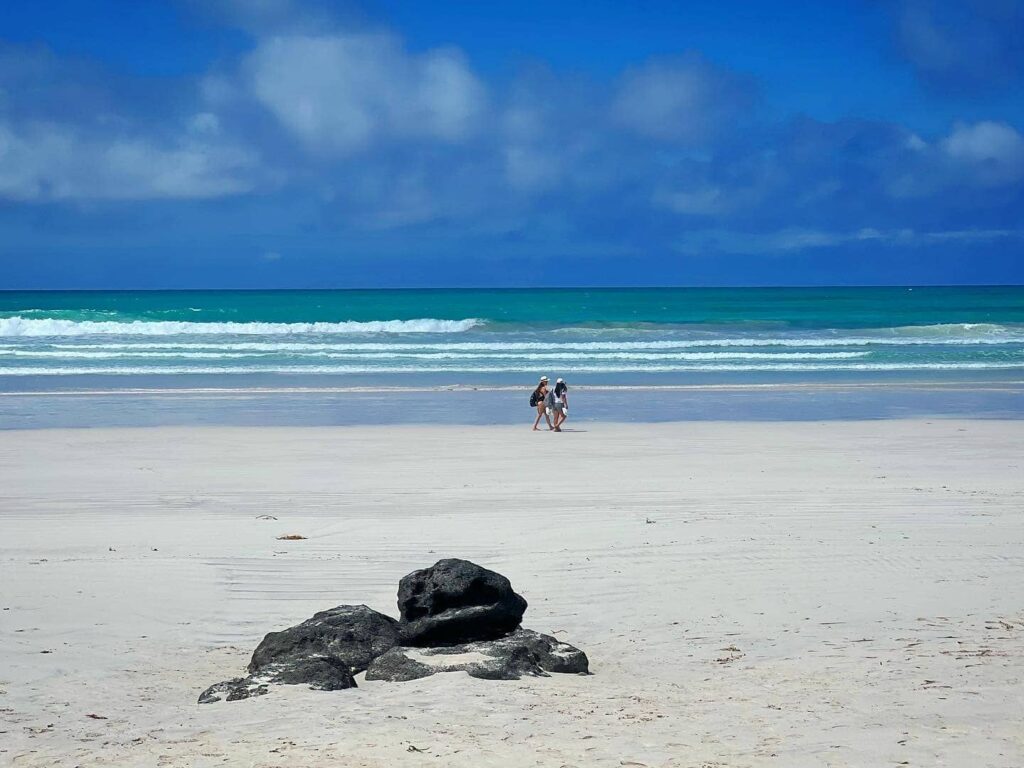Discover the Galapagos Islands: A Complete Guide to Nature’s Living Laboratory
Your Ultimate Resource for Exploring the Enchanted Isles
Imagine standing on a beach where sea lions nap inches from your feet, snorkeling alongside penguins darting through crystalline waters, or hiking a volcano that last erupted in 2022. Welcome to the Galapagos Islands, a remote archipelago where the rules of nature rewrite themselves daily. Located 600 miles off Ecuador’s coast, these 19 volcanic islands and dozens of islets are a UNESCO World Heritage Site and one of Earth’s last truly wild frontiers.
This guide isn’t just a travel primer—it’s a deep dive into the islands’ heart. You’ll uncover where evolution comes alive, how conservationists are saving species from extinction, and why every traveler here becomes an ambassador for sustainability. Galapagos offers a journey that’s as transformative as it is thrilling. It’s no wonder the New York Times listed the islands as the #2 place in the world to visit in 2025! Let us at Galapagos Pronto be your compass!
Why Visit the Galapagos Islands?
Biodiversity Hotspot: Where Evolution Plays Out in Real Time
The Galapagos Islands are a living laboratory of endemic species, shaped by millions of years of isolation. Here’s what makes their wildlife unparalleled:
- Giant Tortoises: These gentle giants, weighing up to 900 pounds, are the islands’ namesake (galápago means “saddle” in Spanish, referencing their shell shape). On Santa Cruz Island, the El Chato Reserve lets you walk among them in misty highland forests.
- Marine Iguanas: Found nowhere else on Earth, these “dragons of the sea” dive 30 feet to graze algae. Watch them sneeze salt on Fernandina Island, the species’ stronghold.
- Blue-Footed Boobies: Their cartoonish blue feet aren’t just for show—males perform a goofy high-step dance to attract mates on North Seymour Island.
- Flightless Cormorants: With stunted wings and voracious appetites, these odd birds thrive on Isabela and Fernandina, where they’ve traded flight for expert diving.
- Galapagos Penguins: The planet’s rarest penguin species, adapted to equatorial heat, nests in lava tubes on Bartolomé Island.
- Waved Albatross: Over 12,000 pairs nest on Española Island (April–December), performing beak-clacking courtship dances.
Why It Matters:
97% of the Galapagos is protected as a national park, safeguarding species that inspired Darwin’s theory of natural selection.
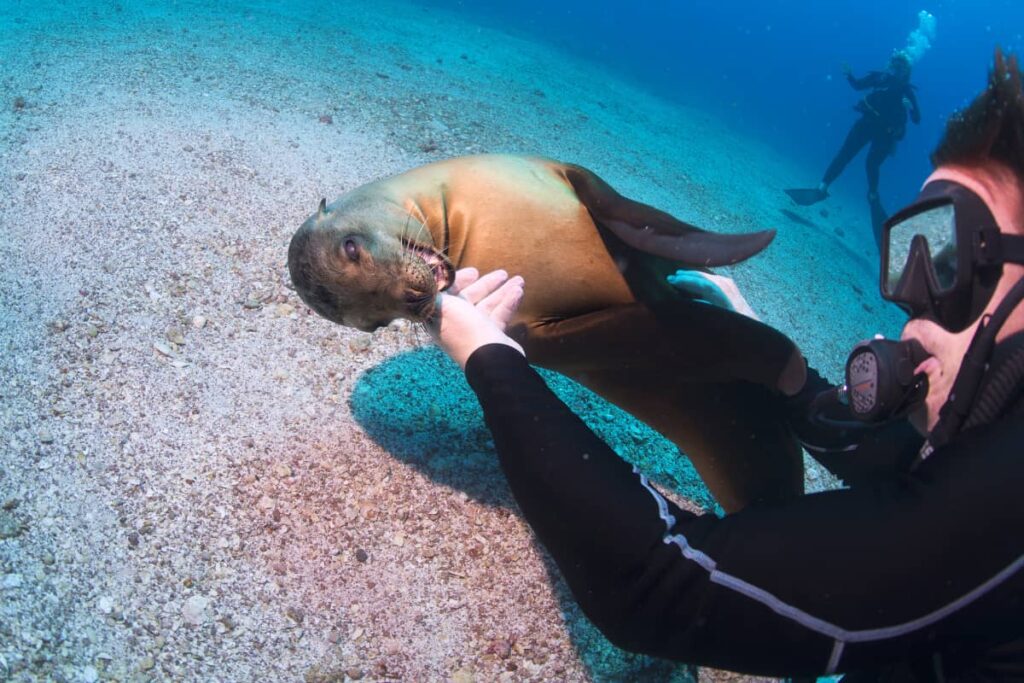
Adventure Travel: From Volcano Summits to Underwater Wonderlands
The Galapagos isn’t a passive sightseeing trip—it’s a playground for explorers:
- Snorkeling & Diving: Swim with hammerhead sharks at Kicker Rock, sea turtles at Tintoreras Islet, and playful sea lions at La Lobería. Advanced divers flock to Wolf and Darwin Islands (June–November) for whale sharks—the ocean’s largest fish.
- Hiking: Trek the Sierra Negra Volcano on Isabela, where a 6-mile-wide caldera (9.7 km)smolders with sulfuric vents. On Bartolomé, climb 372 wooden steps for panoramic views of Pinnacle Rock.
- Kayaking & Paddleboarding: Glide past Galapagos hawks hunting marine iguanas in Tagus Cove (Isabela) or through mangrove forests at Tortuga Bay (Santa Cruz).
- Wildlife Photography: Capture frigatebirds inflating scarlet throat pouches on Genovesa Island or land iguanas munching cacti on South Plaza.
These are just some of the adventures you can embark on, contact us to know more!
The Galapagos Islands: A Snapshot
San Cristobal Island
- Leon Dormido (Kicker Rock): A 500-foot volcanic cone rising from the sea, perfect for snorkeling with Galapagos sharks and eagle rays.
- Punta Pitt: The archipelago’s only site with all three booby species (blue-footed, red-footed, Nazca) nesting side-by-side.
- Cerro Tijeretas: Hike to a cliffside viewpoint for frigatebird colonies and panoramic ocean vistas.
- Full Guide: San Cristobal Island Guide
Santa Cruz Island
- Charles Darwin Research Station: Meet Lonesome George (a taxidermied tortoise symbolizing conservation) and hatchlings in the breeding center.
- Tortuga Bay: A 1.5-mile trail leads to white sands where marine iguanas nest and reef sharks patrol tidal pools.
- Las Grietas: Swim in a 30-foot-deep volcanic fissure filled with crystal-clear water.
- Full Guide: Santa Cruz Island Guide
Isabela Island
- Sierra Negra Volcano: Hike the rim of the world’s second-largest caldera (6 miles wide), steaming with recent volcanic activity.
- Los Tuneles: Snorkel through labyrinthine lava arches teeming with seahorses, penguins, and white-tip reef sharks.
- Giant Tortoise Breeding Center: See hundreds of juveniles destined for wild release.
- Full Guide: Isabela Island Guide
Española Island
- Gardner Bay: A pristine beach where sea lions lounge and Galapagos hawks soar overhead.
- Punta Suárez: Walk past blowholes spraying seawater 75 feet high and watch waved albatrosses clumsily take flight.
- Conservation Legacy: The site of the Galapagos’ most successful tortoise repopulation project.
- Full Guide: Española Island Guide
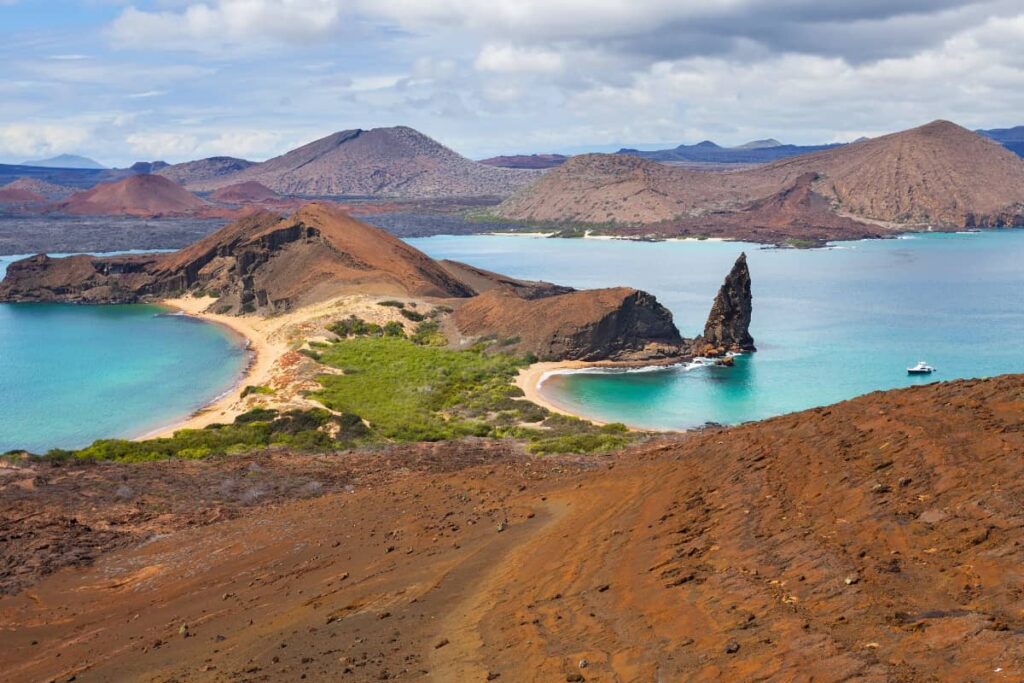
Bartolomé Island
- Pinnacle Rock: This iconic volcanic spearhead, featured in Master and Commander, towers above golden sands. Snorkel around its base to spot Galapagos penguins darting through schools of tropical fish.
- Sullivan Bay: Walk on moon-like lava fields formed by an 1897 eruption, where ropey pāhoehoe lava formations stretch for miles.
- Underwater Wonderland: Dive with white-tipped reef sharks and golden rays in the shadow of Pinnacle Rock.
- Summit Hike: Climb 372 wooden stairs for panoramic views of turquoise bays and distant islands.
- Full Guide: Bartolomé Island Guide
Floreana Island
- Post Office Bay: Participate in a 300-year-old tradition—leave a postcard in the historic barrel or deliver one by hand.
- Devil’s Crown: Snorkel inside a submerged volcanic crater teeming with eagle rays, sea turtles, and vibrant coral.
- Punta Cormorant: Trek to a green-olivine beach and a lagoon where pink flamingos wade alongside stilts.
- The Baroness Murder Mystery: Visit the Wittmer family homestead to unravel the 1930s disappearance of a self-proclaimed empress and her lovers.
- Full Guide: Floreana Island Guide
Genovesa Island
- Prince Philip’s Steps: Scale a steep cliff to a plateau where Nazca boobies nest at your feet and short-eared owls hunt storm petrels.
- Darwin Bay: Stroll along a white-sand beach lined with red-footed boobies nesting in mangrove trees and great frigatebirds displaying scarlet throat pouches.
- Birdwatcher’s Paradise: Over 200,000 seabirds nest here, including the largest red-footed booby colony in the Galapagos.
- Kayak the Caldera: Paddle along the flooded volcanic rim to spot fur seals lounging in rocky crevices.
- Full Guide: Genovesa Island Guide
Santa Fe Island
- Barrington Bay: Swim in turquoise waters with juvenile sea lions playing in the shallows, or snorkel alongside spotted eagle rays.
- Pale Santa Fe Land Iguanas: These endemic, whitish iguanas (unique to the island) munch on Opuntia cacti—some towering over 30 feet tall.
- Hiking the Cliffs: Follow trails through giant prickly pear forests to spot Galapagos hawks and endemic rice rats.
- Conservation Win: Invasive rats were eradicated in 1971, allowing native species to rebound.
- Full Guide: Santa Fe Island Guide
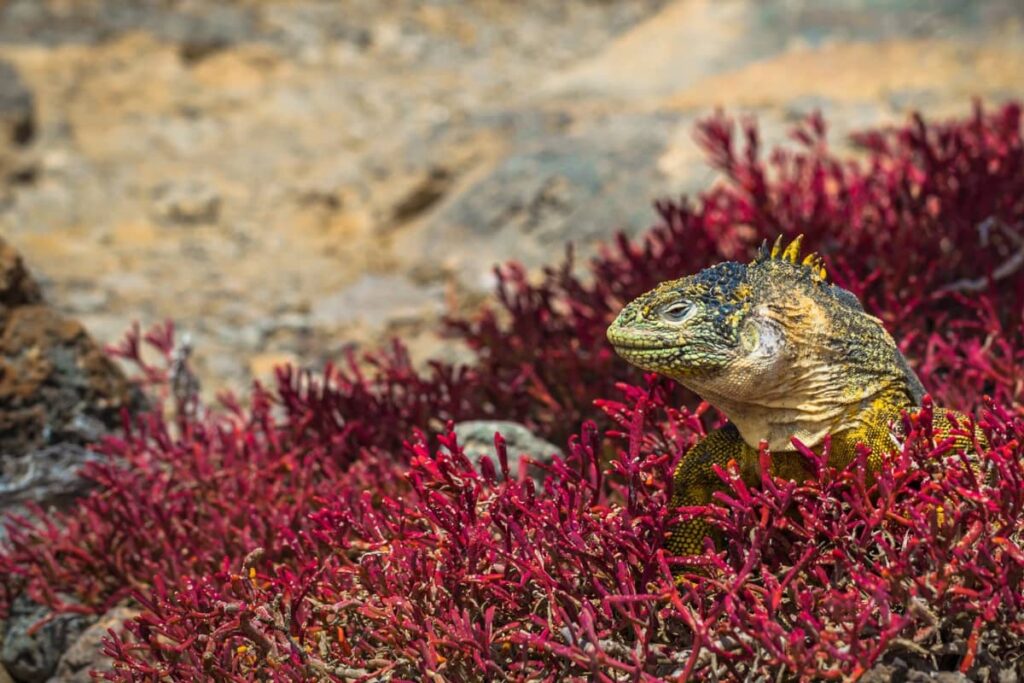
Historical Legacy: From Pirates to Darwin to Modern Science
The Galapagos Islands aren’t just a cradle of evolutionary theory—they’re a stage for human drama, exploration, and folly. Their history is a tapestry of pirates, castaways, scientific breakthroughs, and unsolved mysteries.
Pre-Darwin: A Lawless Haven for Pirates & Whalers
Long before Darwin, the islands were a strategic hideout for those navigating the Pacific:
- 1535: The islands were “discovered” by accident when Spanish Bishop Tomás de Berlanga’s ship drifted off course. He dismissed them as “hellish” due to the harsh lava fields and lack of water.
- 17th–18th Centuries: English pirates like William Ambrosia Cowley mapped the islands, using them to raid Spanish galleons. They named islands after British aristocrats (e.g., King James Island for Santiago).
- 1793–1809: Whalers decimated populations of sperm whales and giant tortoises (used as fresh meat on ships). An estimated 200,000 tortoises were taken, driving some species to extinction.
- Floreana’s Post Office Bay: Whalers left letters in a barrel here, creating the world’s first “post office” relay system. Travelers still practice this 300-year-old tradition today.
Charles Darwin’s Pivotal Visit (1835)
Darwin’s five-week Galapagos stay aboard the HMS Beagle was initially an afterthought. Yet his observations here reshaped science:
- San Cristobal Mockingbirds: On San Cristobal Island, Darwin noticed that mockingbirds differed subtly from those in Chile. This planted the seed for his ideas on adaptation.
- The Finches’ Secret: Ironically, Darwin didn’t recognize the significance of finch beak variations during his visit. He mislabeled many specimens, only realizing their importance back in England with help from ornithologist John Gould.
- Marine Iguanas: Darwin famously called them “hideous-looking” and “clumsy lizards,” yet their unique adaptations (salt-excreting glands) became a textbook example of evolution.
- Santiago Island: Walking the James Bay lava fields, Darwin theorized that volcanic activity shaped the islands’ geology over millennia.
Fun Fact: Darwin only spent 19 days actually exploring the islands and never returned—but his legacy is immortalized in the Charles Darwin Research Station and the islands’ nickname, “The Laboratory of Evolution.”
The Human Quirks: Eccentric Settlers & Mysteries
The Galapagos’ isolation attracted dreamers, outcasts, and opportunists:
- Patrick Watkins (1807–1809): An Irish sailor marooned on Floreana, he survived by trading vegetables with whalers. He later stole a boat and vanished—the islands’ first “Robinson Crusoe.”
- The Baroness Murder Mystery (1930s): Floreana’s strangest chapter began when alleged Austrian Baroness Eloise Wagner de Bosquet arrived, declared herself “Empress of the Galapagos,” and terrorized settlers with a pistol and two lovers. After her disappearance (and the deaths of several others), the case remains unsolved.
- Norwegian Colonies (1920s): A group of Norwegian settlers tried to farm on Santa Cruz and Floreana, lured by utopian ads. Most left within years, defeated by droughts and inhospitable terrain.
20th Century: From Penal Colonies to UNESCO Fame
- 1946–1959: Ecuador established a penal colony on Isabela Island, where prisoners built a wall from jagged lava rocks (still standing as the Wall of Tears). Over 300 died from harsh conditions.
- 1959: The Galapagos National Park was established, protecting 97% of the archipelago. The same year, the Charles Darwin Foundation was founded to advance conservation.
- 1978: UNESCO declared the islands the world’s first Natural World Heritage Site.
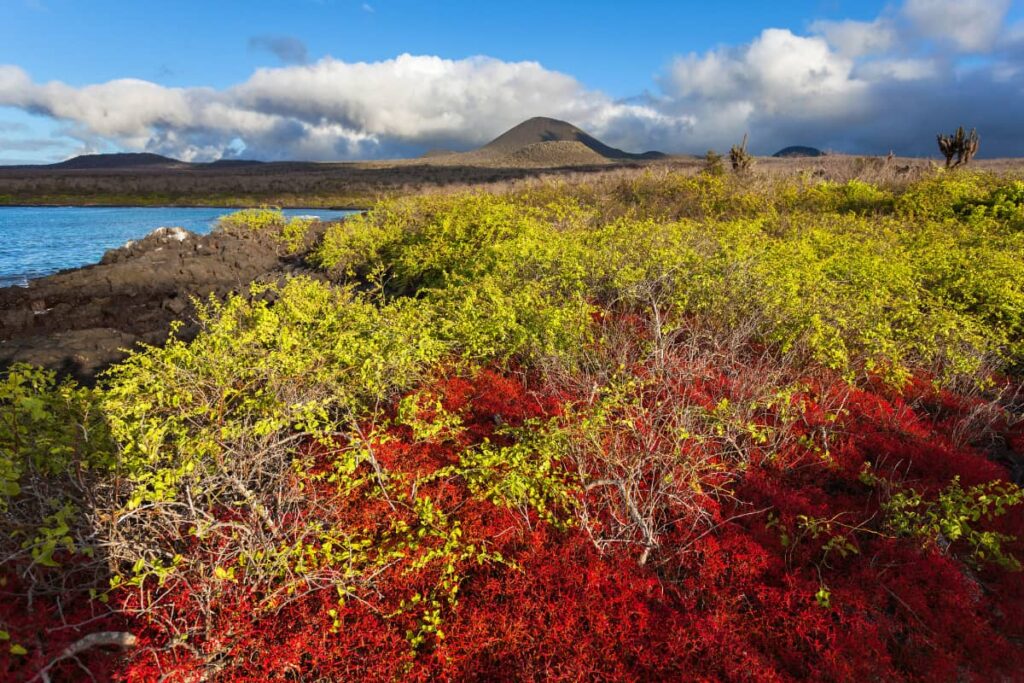
Modern Scientific Legacy
- 1973: Peter and Rosemary Grant began studying Darwin’s finches on Daphne Major, documenting evolution in real-time during droughts (a story told in The Beak of the Finch).
- 2012: The death of Lonesome George, the last Pinta Island tortoise, became a global symbol of extinction—and a rallying cry for conservation.
- 2020: Researchers discovered a giant tortoise species on Fernandina Island (Chelonoidis phantasticus), thought extinct for 113 years.
How to Experience Galapagos History Today
- San Cristobal Interpretation Center: Interactive exhibits trace human history from pirates to space-age conservation.
- Post Office Bay (Floreana): Leave a postcard or deliver one yourself—travelers still honor the 1793 whalers’ tradition.
- Wall of Tears (Isabela): Hike this haunting site where prisoners labored in vain.
- Puerto Ayora Cemetery (Santa Cruz): Graves of settlers and sailors reveal tales of hardship.
Why This History Matters
The Galapagos’ past is a cautionary tale about exploitation—and a testament to resilience. From Darwin’s finches to Lonesome George, the islands remind us that evolution isn’t just about the past; it’s unfolding now, shaped by both nature and human choices.
Sustainability Focus: Conservation Wins You Can Support
The Galapagos Islands are a global blueprint for ecological restoration, proving that even the most damaged ecosystems can heal with targeted action. From resurrecting “extinct” species to pioneering plastic bans, here’s just some of the incredible conservation stories from these legendary islands including some tips on how you can contribute to the islands’ conservation!
Giant Tortoise Revival: Bringing Back Living Legends
Giant tortoises, the islands’ namesake, were nearly wiped out by whalers, pirates, and invasive species. Today, they’re a symbol of hope:
- Española Island’s Miracle: In the 1960s, only 15 Española giant tortoises remained. Through the Fausto Llerena Breeding Center (Santa Cruz), scientists like Dr. Washington Tapia nurtured the population by collecting eggs, incubating them, and releasing juveniles. Over 2,300 tortoises are now thought to roam Española—a population stable enough to sustain itself.
- Diego’s Legacy: One tortoise, Diego, repatriated from San Diego Zoo in 1977, fathered over 800 offspring, single-handedly saving his Chelonoidis hoodensis species. He retired in 2020, dubbed the “greatest Casanova in conservation history.”
- Pinzón Island’s Comeback: After eradicating invasive rats in 2012 (see below), Pinzón saw its first wild tortoise hatchlings in 150 years in 2014. Today, 500+ juveniles thrive without human help.
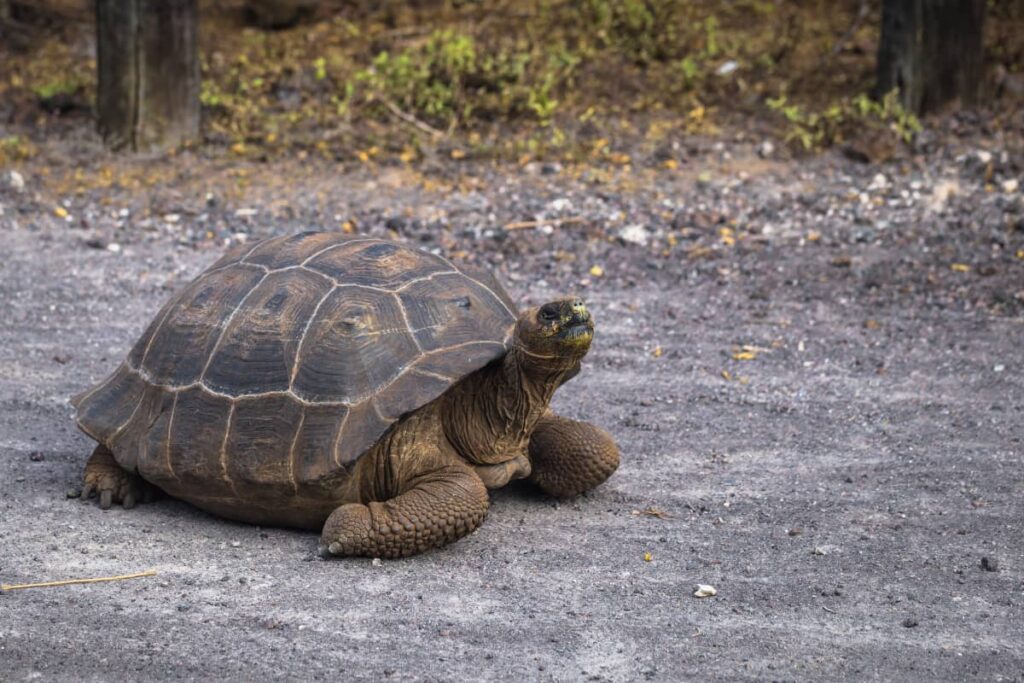
Invasive Species Eradication: Rewilding the Islands
Introduced species like rats, goats, and invasive plants once pushed native wildlife to the brink. Now, the Galapagos is a global leader in ecosystem restoration:
- Project Isabela (1997–2006): The world’s largest invasive mammal eradication effort eliminated 140,000 goats from northern Isabela, Santiago, and Pinta using helicopters, GPS tracking, and “Judas goats” (radio-collared animals that led hunters to herds). Native vegetation rebounded by 80% in a decade.
- Rat-Free Pinzón: In 2012, helicopters dropped 22 tons of rodenticide in precise, timed bursts to protect native species. By 2014, Pinzón’s endemic dwarf geckos and giant tortoises began recovering.
- Scalesia Forests Saved: The invasive blackberry was strangling Santa Cruz’s Scalesia pedunculata (daisy trees). Biologists introduced a biocontrol fungus in 2023 to target the weed without chemicals.
Impact:
- Many islands are now invasive-mammal-free.
- Various bird species, including the Galapagos petrel, have seen nesting success dramatically increase.
How to Help:
- Clean shoes and gear before arriving to prevent introducing seeds or insects.
- Donate to charities like Island Conservation, an NGO leading global eradication efforts for invasive species.
Plastic-Free Galapagos: A Global Model for Ocean Protection
The islands’ 2023 ban on single-use plastics (bags, straws, bottles) is part of a broader war on ocean pollution:
- Results: As of 2024, 72% less plastic washes ashore compared to 2018, thanks to strict fines for non-compliance and community education.
- Recycling Facilities: San Cristobal, Santa Cruz, and Isabela islands all have recycling centers with the goal of reducing waste.
- Pack for a Purpose: Travelers can bring supplies (e.g., reusable water bottles, medical gear) for local schools or join beach cleanups removing 4,000+ lbs of trash annually.
How to Help:
- Bring a reusable water bottle and silicone straw.
- Book tours with Smart Voyager-certified boats, which adhere to zero-plastic policies.
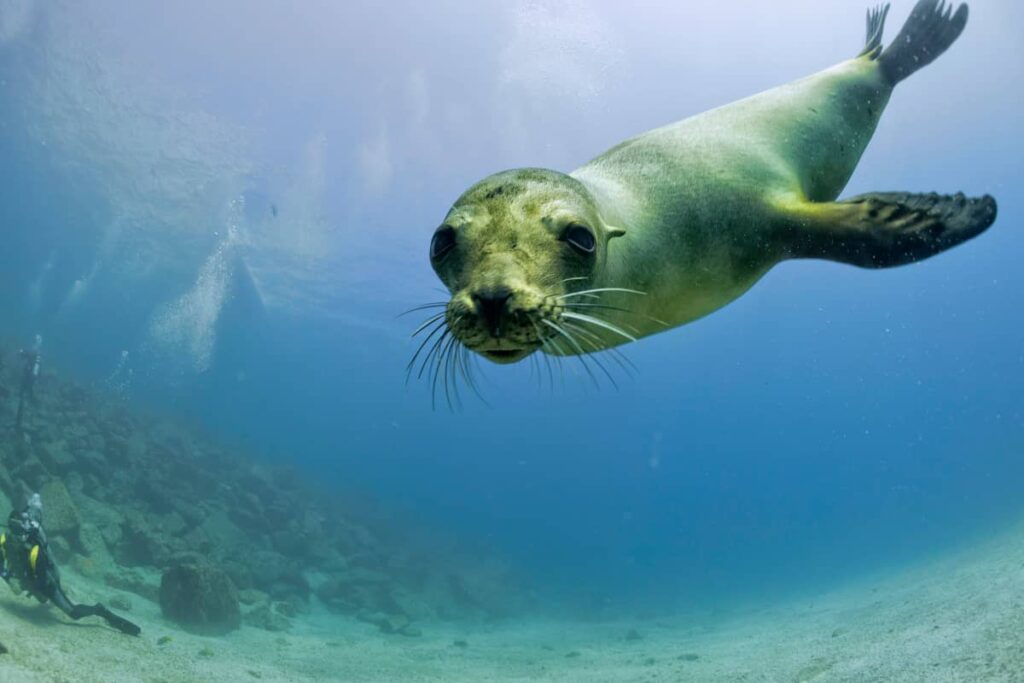
Coral Reef Restoration: Healing Underwater Forests
Warming seas bleached 95% of the Galapagos’ reefs in the 1980s. Now, scientists are regrowing them:
- Nurseries of Hope: Organizations like Reef Revival plant coral fragments on underwater frames near Isabela. Species like Pocillopora (cauliflower coral) now show 60% survival rates.
- Deep Corals: Researchers discovered new deepwater corals (370-420 meters deep/ 1214-1378 ft) in 2023 that offer a habitat for a rich variety of species.
How to Help:
- Use reef-safe sunscreen (avoid oxybenzone and octinoxate). Do some research and find a good one you like! Also, while you can buy some here, it’s probably best to find it in your home country. There is probably a better selection and it’ll most likely be cheaper as well!
- Snorkel responsibly—avoid touching corals or stirring sediment.
Sustainable Fishing & Food Security
Local fishermen now partner with scientists to protect marine life:
- Lobster Season Limits: A 4-month fishing ban lets populations recover, ensuring 1,000+ families can sustainably harvest Galapagos spiny lobster.
- Focus on artisanal fishing: Small-scale fishing practices like using hand lines or spears are thought to be less destructive than industrial fishing methods.
Renewable Energy: Powering the Islands Green
- Solar & Wind: Baltra Airport runs entirely on renewables, while Isabela Island uses hybrid solar-diesel grids to cut emissions by 40%.
- Biogas Revolution: Farms on Santa Cruz convert tortoise and cattle waste into clean energy.
Why These Wins Matter
The Galapagos proves that conservation isn’t a “lost cause”—it’s a series of deliberate, science-driven actions. Every turtle nest protected, every plastic bottle refused, and every invasive plant removed adds up.
Your Role as a Traveler:
- Choose eco-certified tours.
- Don’t leave anything behind! Be sure to dispose of any garbage responsibly.
- Spread the word: Share conservation stories, not just selfies.
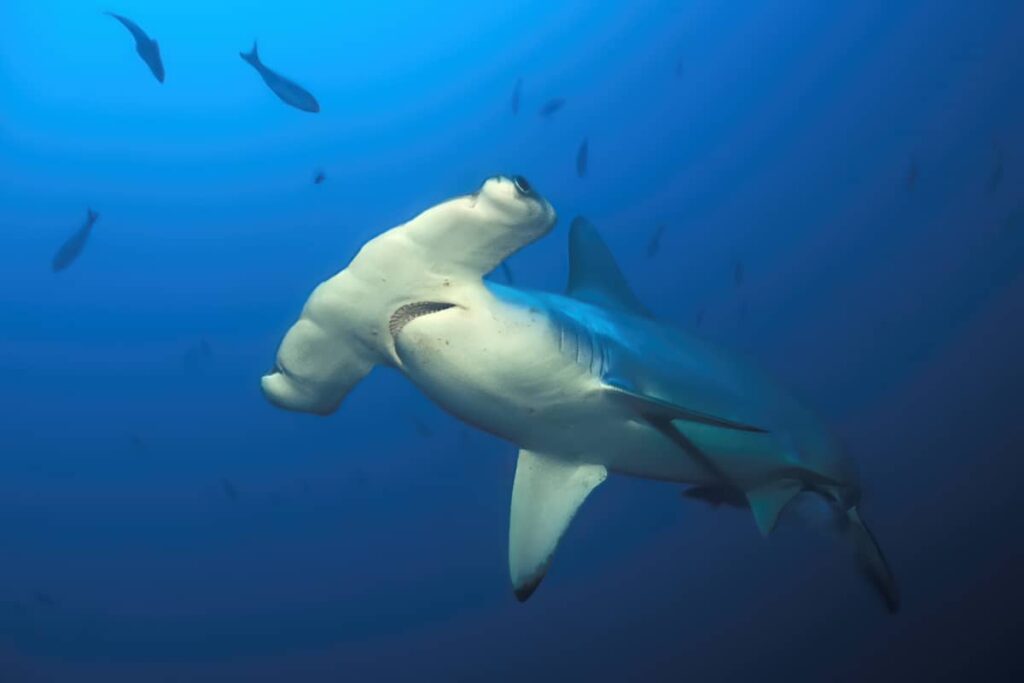
Galapagos Wildlife: Iconic Species & Where to Find Them
Marine Life: Swimming with Ocean Giants
- Whale Sharks (Darwin Island): The world’s largest fish (up to 40 feet) gather June–November, feeding on plankton-rich currents; pregnant females dominate these waters.
- Galapagos Penguins (Bartolomé, Fernandina): The planet’s only equatorial penguin nests in lava tubes, darting through chilly Humboldt Current waters.
- Marine Iguanas (Fernandina, Española): Black-scaled algae-eaters dive 30+ feet, sneezing salt from specialized glands post-dive.
- Manta Rays (Wolf Island, Cabo Marshall): Schools of giant mantas (16-foot wingspans) glide through deep channels, often shadowed by remoras.
- Sea Lions (Mosquera Islet, San Cristobal): Curious pups twirl around snorkelers, while alpha bulls bark to defend harems on beaches.
- Hammerhead Sharks (Gordon Rocks, Darwin, Wolf): Hundreds form “hammerhead highways” in deep waters, especially during mating season (Jan–Mar).
- Galapagos Sharks (Wolf & Darwin): Reef-loving apex predators patrol rocky outcrops, often seen alongside hammerheads.
- Orcas (Bolívar Channel): Transient pods hunt whale calves, sea lions, and even sharks in open waters (peak sightings July–Oct).
- Bottlenose Dolphins (Isabela, Fernandina): Playful pods ride boat wakes and perform acrobatic leaps in sheltered bays.
- Eagle Rays (Gardner Bay, Floreana): Sleek, spotted rays glide in synchronized formations through shallow turquoise lagoons.
- Galapagos Garden Eels (Tintoreras Islet): Colonies of these shy, ribbon-like eels sway in sandy seabeds, retreating when divers approach.
- Red-Lipped Batfish (Isabela’s rocky seabeds): Bizarre bottom-dwellers with bright red “lipstick” and leg-like fins for “walking” on the ocean floor.
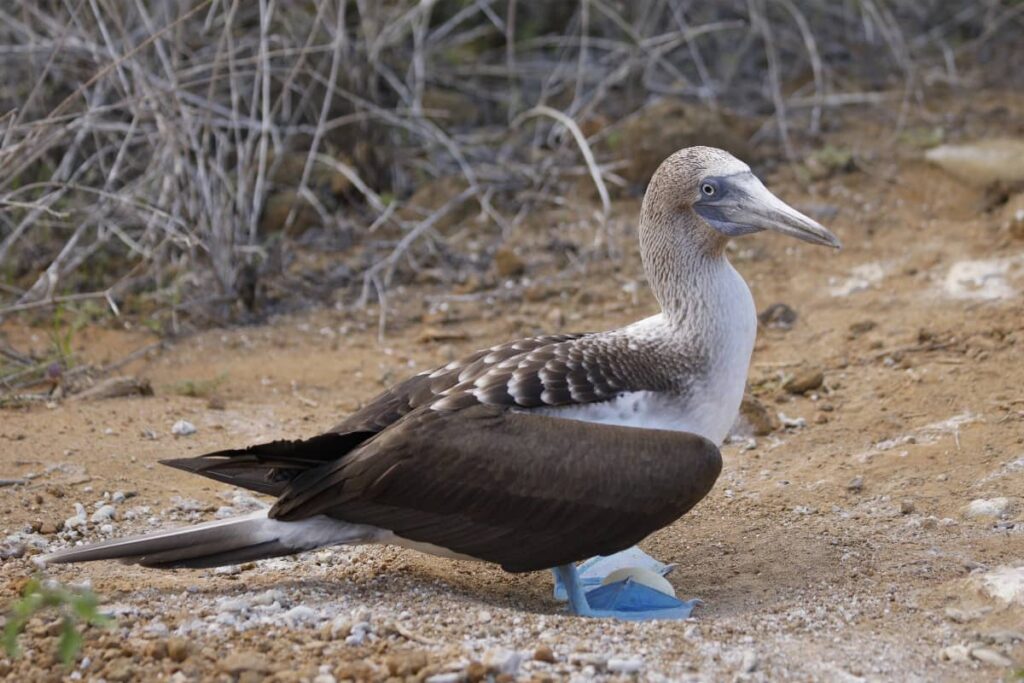
Birdwatching: A Birder’s Paradise
- Waved Albatross (Española Island): The only tropical albatross nests here April–December, performing beak-clacking dances on cliffs.
- Magnificent Frigatebirds (North Seymour, Genovesa): Males inflate scarlet throat pouches to attract mates; often steal food midair.
- Red-Footed Boobies (Genovesa, San Cristobal): Tree-nesting boobies with turquoise bills and candy-red feet dive for squid.
- Galapagos Doves (Santiago, Santa Fe): Crimson-eyed and tame, they forage cactus fruit on lava fields.
- Darwin’s Finches (All islands): 13 species, including tool-using woodpecker finches (Santa Cruz) and blood-drinking vampire finches (Wolf Island).
- Blue-Footed Boobies (North Seymour, Isabela, Española, and others): Famous for their comical mating dance and bright azure feet.
- Flightless Cormorants (Isabela, Fernandina): Wingless divers nesting on rocky shores, found nowhere else on Earth.
- Galapagos Penguins (Bartolomé, Fernandina): The world’s rarest penguin species, adapted to equatorial heat.
- Galapagos Hawks (Española, Santiago): Apex predators hunting lava lizards and marine iguana hatchlings.
- Short-Eared Owls (Genovesa): Hunt storm petrels at dusk, nesting in volcanic crevices.
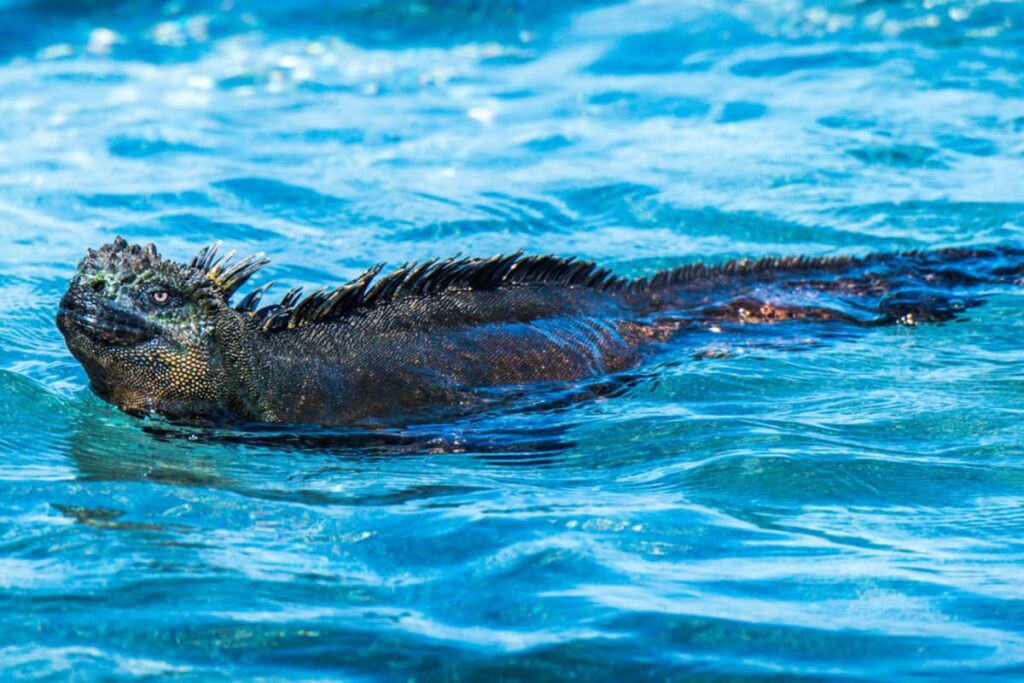
Reptiles: Prehistoric Survivors
- Land Iguanas (South Plaza, Santa Fe): Golden giants eating cactus pads, critical seed dispersers.
- Lava Lizards (Fernandina, Española): Seven island-specific species; Española’s males have fiery red throats.
- Galapagos Green Turtles (Tortuga Bay, Puerto Villamil): Nest December–March, guided by moonlight.
- Marine Iguanas (Fernandina, Española): Only seafaring lizards, diving for algae and sneezing salt.
- Santa Fe Land Iguanas (Santa Fe): Pale, whitish endemics feeding on towering Opuntia cacti.
- Galapagos Giant Tortoises (Santa Cruz, Isabela): 15 subspecies, including Española’s reborn population.
- Galapagos Racer Snakes (Fernandina): Non-venomous hunters of lava lizards and baby iguanas.
- Galapagos Leaf-Tailed Geckos (Santa Cruz, San Cristobal): Nocturnal, camouflaged masters of lava rock.
Planning Your Galapagos Trip
Best Time to Visit
- Dry Season (June–December): Cooler temps (70s°F) ideal for hiking and seeing albatross courtship.
- Warm Season (January–May): Calm seas, warmer water (80s°F) for snorkeling with sea lion pups.
Getting There
- Flights: Daily 2-hour flights from Quito or Guayaquil to Baltra (Santa Cruz) or San Cristobal. See the individual island guides to know how to get to the individual islands you want to see or contact us!
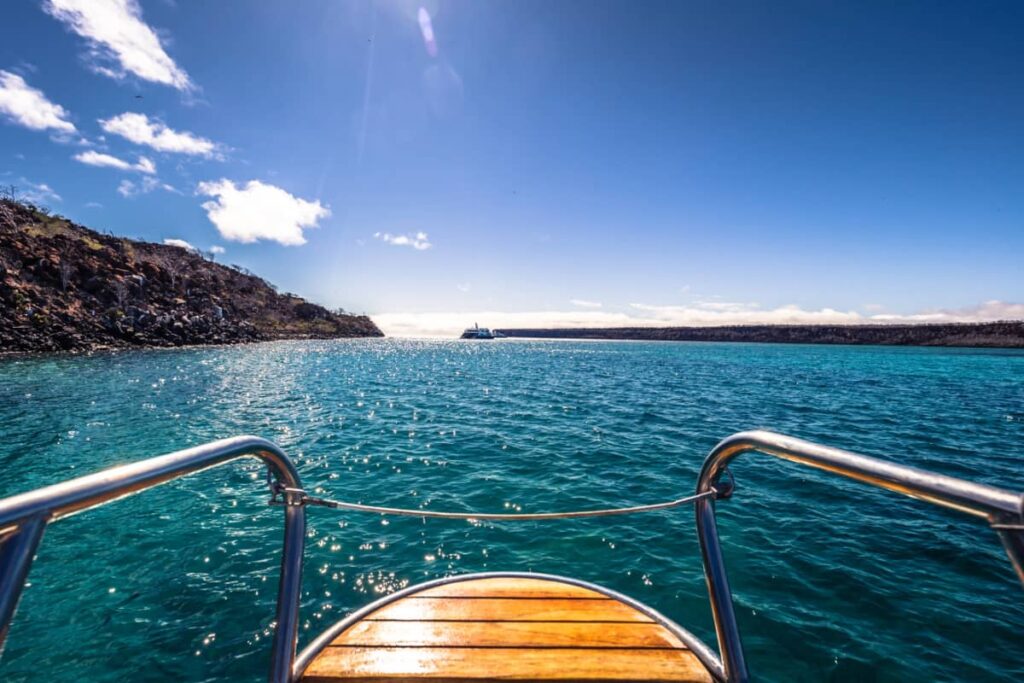
Accommodation: Eco-Lodges vs. Cruises
Eco-Lodges: Immersive, Land-Based Sustainability
Ideal for travelers who prefer stability, flexibility, and direct community engagement.
Pros:
- Lower carbon footprint (no fuel-heavy cruising).
- Supports local economies through staff hires and farm-to-table dining.
- Flexibility to customize daily itineraries.
Cons:
- Limited access to remote islands (e.g., Genovesa, Fernandina).
- Fewer wildlife encounters at night (most tours are daytime only).
Liveaboard Cruises: Access the Remote Archipelago
Best for travelers prioritizing wildlife diversity and hard-to-reach islands.
Budget Cruises
$1,500–$3,500 for a week. Great deals on last-minute cruises available.
- Sustainability: Smart Voyager-certified; supports invasive species eradication.
- Perks: Visits 10+ sites (e.g., Española, Genovesa), onboard naturalists, and family cabins.
Mid-Range Cruises
$4,000–$7,000 for 8 days, even less for last-minute cruises.
- Sustainability: Hybrid engines reduce fuel use; organic meals sourced locally.
- Perks: Jacuzzi, glass-bottom boat tours, and kayaks included.
Luxury Cruises
$5,000–$12,000+ per person. Last-minute deals available.
- Sustainability: Desalination plants onboard; partnerships with CDF for reef monitoring.
- Perks: Private balconies, butler service, and diving excursions to Darwin Island.
Pros:
- Access to protected islands like Darwin and Wolf (diving meccas).
- Nightly wildlife briefings and 24/7 expert guides.
- All-inclusive meals, gear, and permits.
Cons:
- Higher environmental impact (fuel use, wastewater).
- Less flexibility (fixed itineraries).
- Motion sickness risk on open-water crossings.
How to Choose
- Pick Eco-Lodges If: You dislike boats, want to support hyper-local projects, or have mobility issues.
- Choose Cruises If: Remote islands (e.g., Genovesa, Fernandina) or diving with whale sharks is a priority.
- Hybrid Option: Split your trip—some days on a cruise and the rest of the time island hopping!
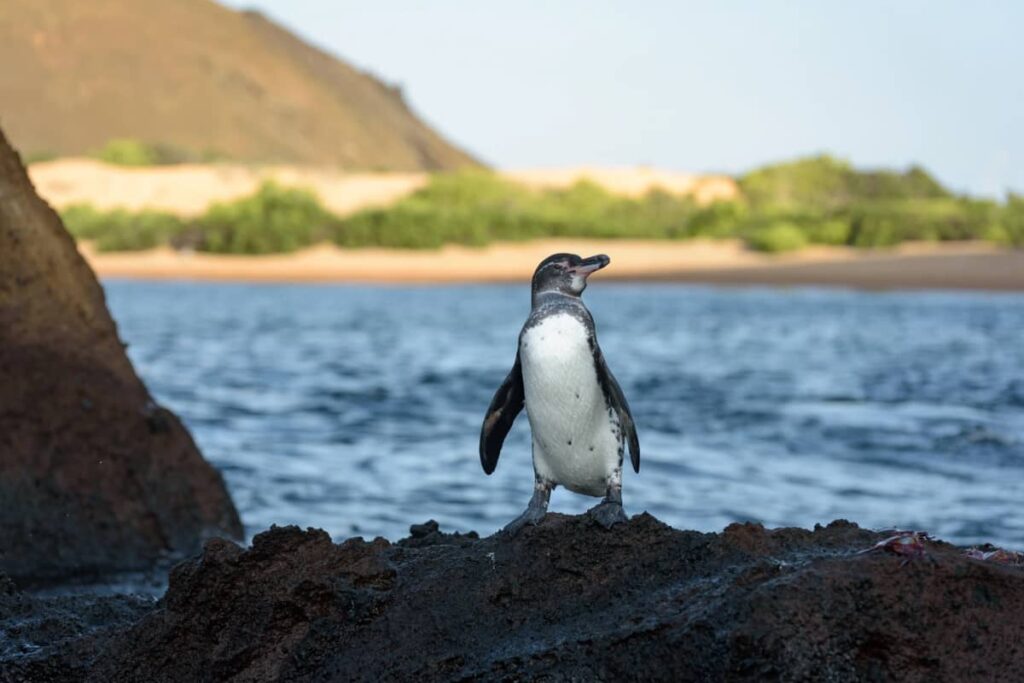
What to Pack
Essentials
- Reef-Safe Sunscreen: Chemical sunscreens (with oxybenzone) are banned in the Galapagos—opt for mineral-based brands.
- Waterproof Dry Bag: Keeps cameras, passports, and cash safe during wet landings. Ziploc bags can also help, but be careful they don’t blow away!
- Motion Sickness Patches/Medication: Boat rides between islands can be choppy—Dramamine or Scopolamine patches are lifesavers.
- Reusable Water Bottle: Tap water isn’t drinkable; many lodges/cruises provide refill stations to reduce plastic waste.
- Quick-Dry Towel: Compact, sand-resistant towels for snorkeling, hiking, and impromptu beach stops.
Clothing
- Lightweight, Long-Sleeved Shirts/Pants: Protects from equatorial sun and mosquitoes (rare but present in highlands).
- Sturdy Hiking Shoes: For volcanic trails (e.g., Sierra Negra’s sharp lava rocks).
- Water Shoes: Protects feet during rocky wet landings (e.g., Fernandina’s jagged shores).
- Wide-Brimmed Hat with Chin Strap: Windproof design to stay on during boat rides.
- Lightweight Rain Jacket: Sudden showers are common in the garúa (misty) season (June–Nov).
Gear
- Snorkel/Mask Set: While most tours provide gear, bringing your own ensures a better fit (opt for a dry-top snorkel to avoid swallowing water).
- Underwater Camera/GoPro: Capture sea turtles, sharks, and penguins—pair with a floating wrist strap to avoid drops.
- Binoculars: Spot distant wildlife (e.g., albatrosses on Española’s cliffs or hawks hunting).
- Portable Power Bank: Limited outlets on boats and during island excursions.
- Waterproof Phone Case: For kayaking, snorkeling, or sudden rain showers.
Health & Safety
- First Aid Kit: Band-aids, antiseptic wipes, and tweezers for cactus spines or minor scrapes.
- Seasickness Remedies: Ginger chews or acupressure wristbands as backups to medication.
- Prescription Medications: Pharmacies are scarce outside Puerto Ayora (Santa Cruz).
- Hand Sanitizer/Wipes: Many sites lack restrooms (e.g., hiking trails on Bartolomé).
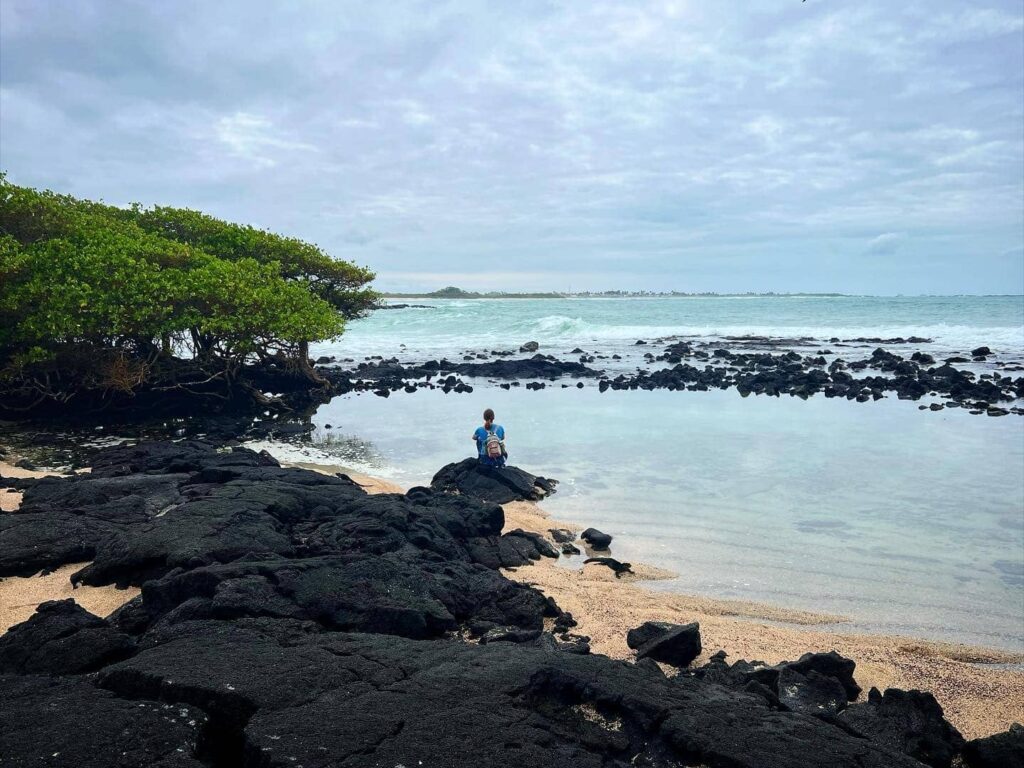
Eco-Friendly Extras
- Reusable Utensils/Straw: Many eateries now comply with the single-use plastic ban.
- Collapsible Tote: For souvenirs or grocery runs in Puerto Ayora (plastic bags are banned).
- Biodegradable Toiletries: Shampoo, soap, and toothpaste to minimize waterway pollution.
Pro Tips
- Pack Light: Small planes to the Galapagos have strict luggage limits (often 1 checked bag ≤ 50 lbs).
- Layer Up: Microclimates vary—highlands are cool/misty, while lowlands are hot and arid.
- Leave “City Clothes” Behind: The vibe is casual (think hiking gear and swimwear, not dresses or suits).
FAQs
Do I need a guide?
Yes—national park rules require certified guides for most or all sites.
How much is the entry fee?
It costs $200 to enter the park for most non-residents of Ecuador. Check out more about this topic here.
Is it safe?
Crime is rare, but dehydration and strong currents pose risks. Carry a reusable bottle and heed snorkel/diving guides. Always book diving with reputable operators!
What’s the average cost for a trip?
- Budget: $1,500 (hostels, group day tours).
- Mid-Range: $5,000 (8-day cruise with meals).
- Luxury: $10,000+ (private yacht charters).
The Galapagos Islands aren’t just a trip - they’re a masterclass in how humans and nature can thrive together. With Galapagos Pronto, you’ll craft an adventure that’s as ethical as it is unforgettable.
Ready to walk with tortoises and swim with sharks?
